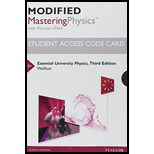
Concept explainers
what plays the role of confining box in a hydrogen atom.
Answer to Problem 1FTD
Quantum numbers associated with the atom plays the role of confinement box.
Explanation of Solution
Particle in a box is a
Here we have to find the entity that acts as the confining box if we consider hydrogen atom to be confined in a box. When we solve the Schrodinger equations of this hydrogen atom we get the various quantum numbers that make the
Write the equation to get the orbital angular momentum.
Here,
Thus we can see that the angular momentum of the atom is an integral multiple of
Conclusion:
Quantum numbers associated with the atom plays the role of confinement box.
Want to see more full solutions like this?
Chapter 36 Solutions
Modified Mastering Physics With Pearson Etext -- Standalone Access Card -- For Essential University Physics (3rd Edition)
- If an atom has an election in the n = 5 state with m = 3, what are the possible values of l?arrow_forwardShow that the maximum number of orbital angular momentum electron states in the nth shell of an atom is n2. (Ignore electron spin.) (Hint: Make a table of the total number of orbital angular momentum states for each shell and find the pattern.)arrow_forwardWhat is the maximum number of orbital angular momentum electron states in the n = 2 shell of a hydrogen atom? (Ignore election spin.)arrow_forward
- Angular momentum and Spin. An electron in an H-atom has orbital angular momentum magnitude and z-component given by L² = 1(1+1)ħ², Lz = m₁h, 1 = 0,1,2,..., n 1 - m₁ = 0, ±1, ±2, ..., ±l 3 S² = s(s+1) h² = =h²₁ 4 Consider an excited electron (n > 1) on an H-atom. The total angular momentum ] = L + Š, whose magnitude and z-component follow a similar dependence to some quantum numbers j and m; as J² = j(j + 1)ħ², Jz = mjħ 1 S₂ = m₂h = ± = h Where j and m; are quantum numbers which assume values that jumps in steps of one such that j is non-negative and −j ≤ m¡ ≤ j. For a given quantum number 1, what are the (two) possible values for j? Clue: we can use the vector sum relation of angular momenta, then consider the z-component only.arrow_forwardSuppose that an atom has (a) 4, (b) 5 electrons in different orbitals. What are the possible values of the total spin quantum number S? What is the multiplicity in each case.arrow_forward(a)What is the magnitude of the orbital angular momentum for an l=3 electron? (b) calculate the magnitude of the electron's spin angular momentum. (c) What is the ratio of the angular momentum?arrow_forward
- Angular momentum and Spin. An electron in an H-atom has orbital angular momentum magnitude and z-component given by L² = 1(1+1)ħ², 1 = 0,1,2,..., n-1 Lz = m₂ħ, m₁ = 0, ±1, ±2,..., ±l 3 S² = s(s+1)h² = h², 4 Consider an excited electron (n > 1) on an H-atom. Sz = msh 1 =+=ħ Show that the minimum angle that the I can have with the z-axis is given by n-1 n L.min = cos Clue: the angle a vector with magnitude V from the z-axis can be computed from cos 0 = V²/Varrow_forwardA neutral calcium atom (Z = 20) is in its ground state electronic configuration. How many of its electrons are in the n =3 level? Explain how you arrived at your answer.arrow_forwardHow many electrons can occupy the system with l=0, l=2 and l=4. What is number of possible orientations of the orbital angular momentum with l=4? What is the smallest z-component of the orbital angular momentum?arrow_forward
- Which of the following is a permissable set of quantum numbers for an electron in a hydrogen atom? The atom may be in an excited state (ie. the electron need not be in its ground state). a) n = 6, l = -5, ml = +4, ms = +1/2 b) n = 4, l = -2, ml = +2, ms = -1/2 c) n = 2, l = 2, ml = +1, ms = -1/2 d) n = 5, l = 1, ml = -1, ms = +1/2 e) n = 3, l = 2, ml = -2, ms = -1arrow_forwardConsider the seventh excited level of the hydrogen atom. (a) What is the energy of this level? (b) What is the largest magnitude of the orbital angular momentum? (c) What is the largest angle between the orbital angular momentum and the z-axis?arrow_forward(a) The doubly charged ion N2+ is formed by removing two electrons from a nitrogen atom. What is the ground-state electron configuration for the N2+ ion? (b) Estimate the energy of the least strongly bound level in the L shell of N2+. (c) The doubly charged ion P2+ is formed by removing two electrons from a phosphorus atom. What is the ground-state electron configuration for the P2+ ion? (d) Estimate the energy of the least strongly bound level in the M shell of P2+arrow_forward
 Principles of Physics: A Calculus-Based TextPhysicsISBN:9781133104261Author:Raymond A. Serway, John W. JewettPublisher:Cengage Learning
Principles of Physics: A Calculus-Based TextPhysicsISBN:9781133104261Author:Raymond A. Serway, John W. JewettPublisher:Cengage Learning College PhysicsPhysicsISBN:9781305952300Author:Raymond A. Serway, Chris VuillePublisher:Cengage Learning
College PhysicsPhysicsISBN:9781305952300Author:Raymond A. Serway, Chris VuillePublisher:Cengage Learning University Physics Volume 3PhysicsISBN:9781938168185Author:William Moebs, Jeff SannyPublisher:OpenStax
University Physics Volume 3PhysicsISBN:9781938168185Author:William Moebs, Jeff SannyPublisher:OpenStax Modern PhysicsPhysicsISBN:9781111794378Author:Raymond A. Serway, Clement J. Moses, Curt A. MoyerPublisher:Cengage Learning
Modern PhysicsPhysicsISBN:9781111794378Author:Raymond A. Serway, Clement J. Moses, Curt A. MoyerPublisher:Cengage Learning



